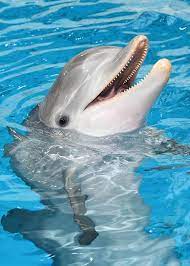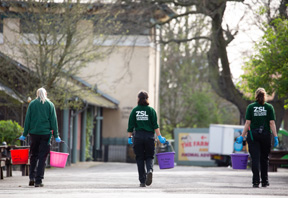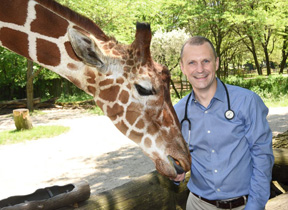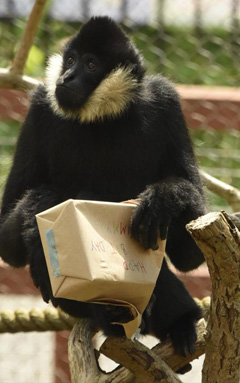Merlin the dolphin

Brookfield Zoo photo
Merlin, a bottlenosed dolphin, enjoys watching visitors at Chicago's Brookfield Zoo. A drop in visitor numbers due to the pandemic has left many zoos struggling to stay afloat.
At Brookfield Zoo in Chicago, Merlin and the five other bottlenose dolphins didn't get to see any visitors for months. They usually enjoy watching people through the glass of an underwater viewing room, swimming playfully alongside them as they walk by.
Almost 4,000 miles away in England, Jimmy the gibbon is compensating for the lack of audiences at London Zoo by showing off his climbing skills to people over the boundary fence in neighboring Regent's Park.
The pandemic, by causing a steep drop in visitor numbers, has been tough on extroverts such as Jimmy and Merlin. But it's the humans who work at the world's thousands of zoos, including many veterinarians, who are arguably missing the visitors most.
"It's definitely not something our animals or our staff have experienced before," Dr. Michael Adkesson, a veterinarian at Brookfield Zoo, said of the prolonged drop in patronage. "But, in some ways, it's stranger for the staff — who are completely unaccustomed to not having visitors to engage with."
For many practitioners, the past year has been as stressful as it has been strange. Pushed to the brink of collapse by a huge drop in ticket sales, zoos have been forced to lay off or furlough thousands of workers. At least one accredited zoo, Vancouver Aquarium in Canada, has shut its doors to the public indefinitely. Another, Living Coasts in Torquey, England, closed permanently, forcing it to relocate its animals. Even zoos that have reopened are capping visitor numbers to ensure adequate social distancing, limiting a rebound in ticket sales.
Zoo keepers

Zoological Society of London photo
Zookeepers at the London Zoo take care to maintain distance from one another to reduce the risk of transmitting or contracting the coronavirus.
For the most part, zoo veterinarians have held onto their jobs since animals need care, regardless. Still, some practitioners remain on edge as parks continue to struggle — especially those with large indoor sections that can't as easily enforce social distancing, such as aquariums. Veterinarians contacted by the VIN News Service also told of reduced pay and hours; tedious operating conditions to prevent the spread of COVID-19 (including among the animals); a reduction in elective procedures; and freezes on vital conservation work.
"We are being very careful with every expenditure," Dr. Amanda Guthrie, a veterinarian at London Zoo, which lost £20 million ($29 million) of revenue in 2020, said via email. "But animal welfare and health is our top priority, so we refuse to compromise on food quality and animal care."
From London to Sydney, an unhealthy hibernation
Dr. Adkesson 288

Brookfield Zoo photo
Dr. Michael Adkesson, shown with a giraffe named Arnieta, reports that visitors are returning enthusiastically to Chicago's Brookfield Zoo as pandemic-control restrictions loosen.
The extent to which the world's zoos are suffering depends, in part, on the number and duration of lockdowns they've faced. London Zoo, for example, is currently closed because the United Kingdom is in the midst of a third COVID-19 nationwide lockdown. Brookfield Zoo in the United States reopened on March 1 but is admitting only 25% of capacity.
Dan Ashe, chief executive of the U.S.-based Association of Zoos and Aquariums, reckons its 240 members — located in 13 countries — have lost roughly 25% to 40% of their pre-pandemic revenue. He's impressed by how well they're coping.
"At the beginning of the pandemic, there was significant concern about zoos' ability to maintain care for animals," he told VIN News on a video call. "But that, fortunately, has not come to pass at all."
Ashe notes that AZA members must meet strict criteria to earn accreditation, including proving they have the wherewithal to care for residents. The collective fate of the many zoos, aquariums and wildlife parks that lack professional accreditation is less clear.
Zoos' survival also has been influenced by the amount of government funding they can tap. In the U.S., Ashe said, smaller zoos can access worker subsidies through the Small Business Administration's Paycheck Protection Program. Many larger companies, however, haven't had much support. SeaWorld, for instance, booked losses of $45.5 million across all its locations for the fourth quarter of 2020.
Jimmy

Zoological Society of London photo
Jimmy, a gibbon with a big personality, opens a present of leafy greens he received for his 30th birthday last May.
And some government assistance programs are proving more effective than others. Zoos in the U.K., for instance, are complaining that a £100 million (US$139 million) package there isn't very helpful — because it requires them to be down to their last 12 weeks of funding before they can even apply. Some of Britain's largest zoos wrote an open letter to the government this month asking the funding be made more accessible.
"We know that lockdowns, restrictions and the lack of available government support continues to represent a clear danger to the survival of some of our members," Jo Judge, chief executive of the British and Irish Association for Zoos and Aquariums, told VIN News. Judge said 44 zoos had tapped the U.K. support package, out of more than 300 license holders there. At least four British zoos that don't hold BIAZA accreditation also have closed due to the pandemic: Cathedral Falconry Centre, Sandwich Wildlife Park, Tamar Otter Sanctuary and Ventura Wildlife Park.
Even in countries with relatively few COVID-19 cases, visitor volumes have shrunk due to lockdowns and international border closures. The Australian government last year offered its zoos an AU$95 million (US$73 million) lifeline. In Hong Kong, Ocean Park zoo and aquarium was provided in January with up to HK$2.79 billion (US$350 million) in government support. Dr. Sarah Churgin, along with many of her Ocean Park colleagues, has taken a pay cut — in her case initially of about 21%, later improving to 10%.
Meanwhile, Churgin said Ocean Park's veterinarians have in no way skimped on care. They're also collaborating closely with trainers to keep residents entertained. "The trainers have gone above and beyond to ensure that the animals are getting plenty of mental and physical exercise," Churgin said via email.
Elsewhere, two zoos in the Czech Republic have allowed their chimps to see each other over Zoom to compensate for the lack of visitors.
(Not all zoo animals like human visitors. A study by University of Melbourne researchers published in 2019 concluded that preferences may be due to "species-specific differences, the nature and intensity of the visitor interactions, enclosure design, and individual animal characteristics.")
Stage set for a reawakening
Another way the pandemic hit zoos
When zoo animals have needed medical attention during lockdowns, treating them hasn't always been easy. Adkesson, who also is vice president of clinical medicine at the Chicago Zoological Society, said Brookfield Zoo's veterinarians and veterinary technicians were split into teams to reduce the likelihood of everyone catching COVID-19. "That obviously reduced our on-site staff numbers and our ease of operations quite a bit," he said.
London Zoo, too, has separated practitioners and instructed them to regularly work from home, including when teaching students. "There are several members of my team that I haven't seen in person in a year, although we regularly catch up over Teams calls," Guthrie said. "We are normally a big, close team that eat lunch together and see each other socially, so we're all feeling socially isolated and really missing each other and the collaboration (and fun!) that we normally have."
Many elective procedures, including preventive medicine exams, have been put on hold to reduce time spent working together, according to Adkesson and Guthrie.
The movement of animals between zoos for breeding programs has been disrupted, though Adkesson said transports are starting to pick up again in the U.S. as many zoos there tentatively reopen. Conservation efforts also have been hit hard by funding pressures, given such work is largely supported by gate sales.
Adkesson personally is involved with a program in coastal Peru — monitoring movement and foraging patterns of penguins and South American fur seals — for which field work ground to a halt for much of 2020. On the bright side, the AZA's Ashe notes, the latest U.S. stimulus package, worth $1.9 trillion, contains $30 million to support facilities taking care of threatened and endangered species, like Audubon Zoo in New Orleans, with its whooping cranes; Point Defiance Zoo in Tacoma, Washington, with its red wolves; and Zoo Tampa, with its manatees.
More broadly, Ashe is optimistic that AZA members are on the road to recovery. "I don't foresee any zoo closures right now, given the trends with regards to vaccination and the economy writ large," Ashe said. "Of course, if we have a relapse and things deteriorate again, then all bets could be off."
Adkesson, too, sees "light at the end of the tunnel" as visitors, keen to get out of the house, return enthusiastically to Brookfield Zoo.
Even in Britain, London Zoo is literally sowing the seeds of a recovery amid plans for the U.K.'s latest lockdown to end next month, Guthrie said. "Our horticulture team have kept hard at work throughout lockdown so that the site will be in beautiful full bloom when we open in April."